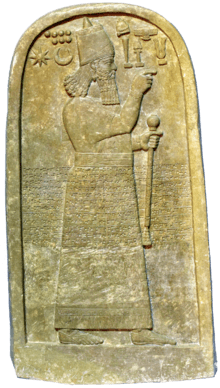Tudiya
Tudiya or Tudia (Akkadian: 𒂅𒁲𒅀, romanized: Ṭu-di-ia) is the earliest Assyrian king named in the Assyrian King List,[1] and the first of the “seventeen kings who lived in tents.”[2][3] His existence is unconfirmed archaeologically and uncorroborated by any other source. According to the Assyriologist Georges Roux, Tudiya would have lived in the latter half of the 25th century BC (i.e. somewhere between fl. c. 2450 BC — fl. c. 2400 BC.) Tudiya was succeeded by Adamu.[4]
| Tudiya | |
|---|---|
| Assyrian king | |
| Reign | fl. 'c. 2450 BC — c. 2400 BC |
| Predecessor | new creation |
| Successor | Adamu |
Geopolitical context
Tudiya is succeeded on the Assyrian King List by Adamu and then a further thirteen rulers: Yangi, Suhlamu, Harharu, Mandaru, Imsu, Harsu, Didanu, Hana, Zuabu, Nuabu, Abazu, Belu, Azarah, Ushpia, and Apiashal. Nothing concrete is yet known about these names, although it has been noted that a much later Babylonian tablet listing the ancestral lineage of Hammurabi of Babylon, seems to have copied the same names from Tudiya through Nuabu, though in a heavily corrupted form: Tudiya's name seems to be joined with that of Adamu to appear there as Tubtiyamutu.
In initial archaeological reports from Ebla, it appeared that Tudiya's existence was confirmed with the discovery of a tablet where it was stated that he had concluded a treaty for the operation of a kārum in Eblaite territory, with "King" Ibrium of Ebla (who is now known to have instead been the vizier of the King Isar-Damu of Ebla.) This entire reading is now questionable, as several scholars have more recently argued that the treaty in question was not with king Tudiya of Assur at all, but rather with the unnamed king of an uncertain location called "Abarsal". Assyria seems to had already been firmly involved in trade in Anatolia by this time; the earliest known reference to Anatolian kārums in Hatti was found on later cuneiform tablets describing the early period of the Akkadian Empire. On those tablets, Assyrian traders in Purushanda had implored the help of their ruler, Sargon of Akkad, and this appellation continued to exist throughout Assyria for about 1700 years. The name, “Hatti” appears in later accounts of Sargon of Akkad's grandson (Naram-Sin of Akkad) campaigning in Anatolia. Both Assyrian and Akkadian traders had spread the use of writing in the form of the Mesopotamian cuneiform script to both Anatolia and the Levant.
The earliest Assyrian kings recorded as “kings who lived in tents” (such as Tudiya) had at first been independent semi-nomadic pastoralist rulers; Assyria is thought to have begun as an oligarchy rather than a monarchy. These kings at some point became fully urbanized and founded the city-state of Assur.[5]
The region of Assyria, north of the seat of the empire in central Mesopotamia, had been known as Azuhinum in Akkadian records.[6] Towards the end of the reign of Sargon the Akkad, the Assyrian faction had rebelled against him; “the tribes of Assyria of the upper country—in their turn attacked, but they submitted to his arms, and Sargon settled their habitations, and he smote them grievously.”[7]
| Preceded by new creation |
Assyrian king fl. c. 2450 BC — c. 2400 BC |
Succeeded by Adamu |
See also
- Timeline of the Assyrian Empire
- Early Period of Assyria
- List of Assyrian kings
- Assyrian continuity
- Assyrian people
- Assyria
References
- https://www.livius.org/sources/content/anet/564-566-the-assyrian-king-list/?
- Glassner, Jean-Jacques (2004). Mesopotamian Chronicles. Society of Biblical Literature. p. 137. ISBN 1589830903.
- Meissner, Bruno (1990). Reallexikon der Assyriologie. 6. Berlin: Walter de Gruyter. p. 103. ISBN 3110100517.
- Roux, Georges (Aug 27, 1992). Ancient Iraq. Penguin Books Limited. ISBN 978-0140125238.
- Saggs, The Might, 24.
- "Prehistory and Protohistory of the Arabian Peninsula: Bahrain". M. A. Nayeem. 1990. p. 32.
- Malati J. Shendge (1 January 1997). The language of the Harappans: from Akkadian to Sanskrit. Abhinav Publications. p. 46. ISBN 978-81-7017-325-0. Retrieved 22 April 2011.
Bibliography
- Edmond Sollberger, "the so-called treaty between Ibla and 'Ashur'", Studii Eblaiti 3 (1980:129-155).
